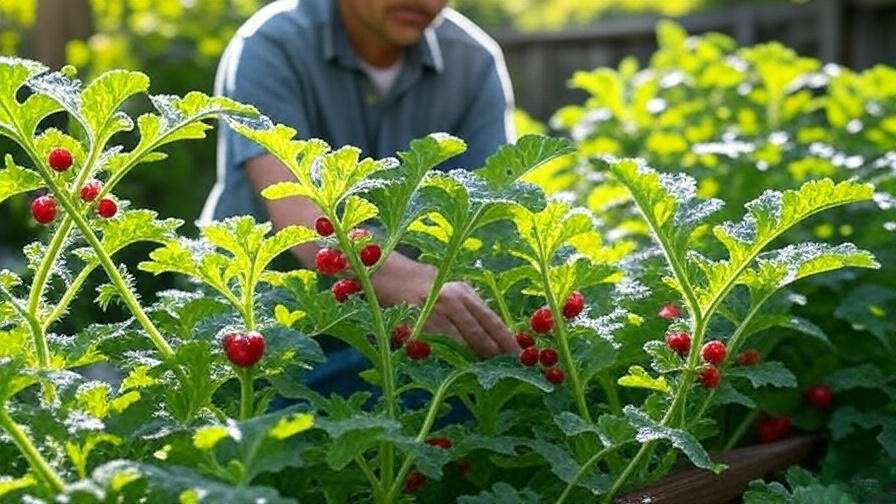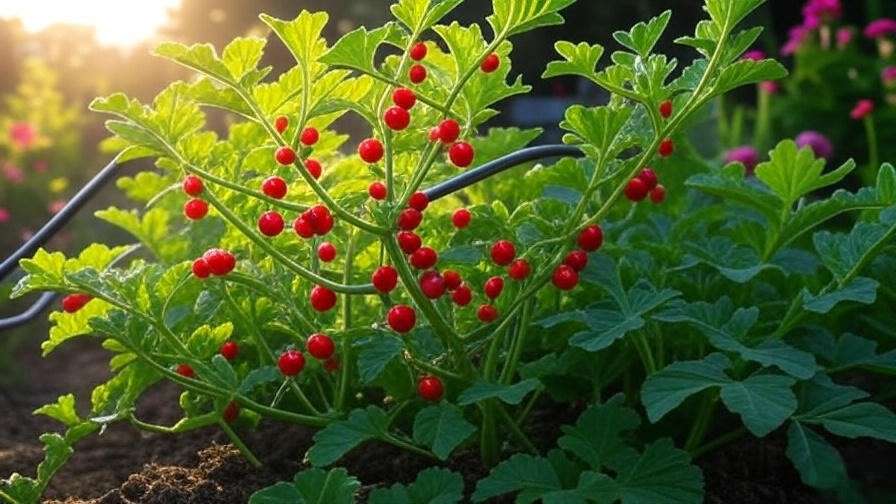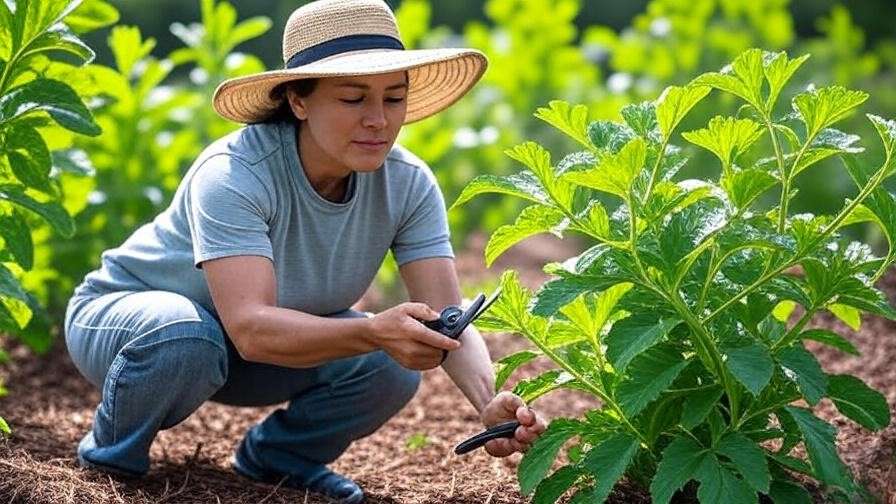Imagine biting into a tiny, ruby-red berry that bursts with the sweet, juicy essence of watermelon — all grown in your own backyard! The watermelon berry plant, a delightful hybrid or cultivar like Fragaria vesca, is stealing the hearts of gardeners with its compact size, vibrant fruit, and low-maintenance charm. Whether you’re a seasoned grower or a newbie with a sunny balcony, this unique plant offers a rewarding way to elevate your garden and plate. In this comprehensive guide, you’ll discover expert-backed tips to plant, nurture, and harvest a thriving watermelon berry plant, ensuring a bountiful yield of delicious, nutrient-packed berries. Let’s dig in and unlock the secrets to vibrant fruit! 🌿
1. Understanding the Watermelon Berry Plant 🍉
1.1 What Is a Watermelon Berry Plant? 🌿
The watermelon berry plant, often a variety of alpine strawberry (Fragaria vesca) or a specialized hybrid, is a compact, fruit-bearing perennial known for its small, red berries that carry a subtle watermelon-like flavor. Unlike traditional strawberries, these plants are typically day-neutral, meaning they produce fruit throughout the growing season, not just in June. Their petite size (6–12 inches tall) and vibrant foliage make them ideal for small gardens, containers, or even as ornamental edging. Native to Europe and parts of Asia, these plants have been cultivated for centuries, with modern hybrids enhancing their unique flavor profile.
1.2 Benefits of Growing Watermelon Berry Plants 🌼
Why choose a watermelon berry plant for your garden? Here’s why they’re a must-have:
- Nutritional Powerhouse: Packed with vitamin C, vitamin K, antioxidants, and dietary fiber, these berries support immune health and digestion.
- Aesthetic Appeal: Their lush green leaves and bright red berries add a pop of color to patios, balconies, or garden beds.
- Low Maintenance: Perfect for beginners, these plants require minimal upkeep compared to larger fruit crops.
- Versatile Growth: Thrive in containers, raised beds, or in-ground setups, making them accessible for urban gardeners.
- Year-Round Potential: In mild climates or with proper care, some varieties remain evergreen, offering year-round beauty.
2. Choosing the Right Watermelon Berry Variety 🌱
2.1 Popular Varieties to Consider 🍓
Selecting the right variety is key to success. Here are some top watermelon berry plant varieties:
- Fragaria vesca ‘Alexandria’: A day-neutral alpine strawberry with small, sweet berries and a hint of watermelon flavor. Ideal for containers.
- Fragaria ‘Mara des Bois’: A hybrid with intense, juicy berries that blend strawberry and watermelon notes. Great for temperate climates.
- Fragaria vesca ‘Mignonette’: Compact and prolific, perfect for small spaces and cooler regions.
| Variety | Fruit Size | Yield | Hardiness Zones | Best For |
| Alexandria | Small | High | 4–8 | Containers, patios |
| Mara des Bois | Medium | Moderate | 4–9 | In-ground, warm climates |
| Mignonette | Small | High | 3–8 | Small spaces, cooler climates |
2.2 Selecting Plants for Your Climate Zone ☀️
Watermelon berry plants thrive in USDA hardiness zones 3–9, but variety selection depends on your local climate. Check your zone using the USDA Plant Hardiness Zone Map. For colder regions (zones 3–5), opt for cold-tolerant varieties like ‘Mignonette.’ In warmer zones (7–9), ‘Mara des Bois’ excels. If you’re in a transitional zone, consult your local agricultural extension service for tailored advice. Expert Tip: Always choose certified disease-free plants from reputable nurseries to ensure healthy stock.
3. Planting Your Watermelon Berry Plant: Step-by-Step Guide 🌍
3.1 When and Where to Plant 📅
Timing and location are critical for a thriving watermelon berry plant. Plant in early spring or early fall to allow roots to establish before extreme heat or cold. Choose a site with:
- Full Sun: 6–8 hours of direct sunlight daily for optimal fruit production.
- Good Drainage: Avoid low-lying areas where water pools to prevent root rot.
- Container Option: For urban gardeners, use 10–12-inch pots with drainage holes.
3.2 Preparing the Soil 🧑🌾
Watermelon berry plants prefer slightly acidic soil (pH 5.5–6.5) rich in organic matter. Test your soil using a home pH kit or send a sample to a local extension service. To prepare:
- Loosen soil to a depth of 12 inches.
- Mix in compost, aged manure, or peat moss to improve fertility and drainage.
- If pH is too high, add elemental sulfur; if too low, incorporate lime.
3.3 Planting Techniques 🌱
Follow these steps for successful planting:
- Choose Healthy Plants: Select runners, bare-root plants, or seedlings with vibrant green leaves and no signs of disease.
- Spacing: Space plants 12–18 inches apart to ensure air circulation and room for runners.
- Planting Depth: Set the crown (where roots meet stems) at soil level to prevent rot.
- Water Thoroughly: Water immediately after planting to settle the soil.
Real-World Example: A gardener in Oregon successfully planted ‘Alexandria’ in raised beds, yielding berries within 3 months by following these steps.
4. Essential Care Tips for a Thriving Watermelon Berry Plant 🌞
4.1 Watering Needs 💧
Consistent moisture is crucial, but overwatering can harm your plants. Aim for 1–2 inches of water per week, adjusting for rainfall. Use drip irrigation or water in the morning to keep foliage dry and reduce disease risk. Watch for:
- Overwatering Signs: Yellowing leaves, soggy soil, or root rot.
- Underwatering Signs: Wilting, dry soil, or small, shriveled berries.
4.2 Fertilizing for Healthy Growth 🌿
Feed your watermelon berry plant with a balanced 10-10-10 fertilizer or organic alternatives like fish emulsion. Apply in early spring and again in mid-summer. Avoid over-fertilizing, as excess nitrogen promotes leafy growth over fruit. Pro Tip: Use a slow-release fertilizer for consistent nutrient delivery.
4.3 Pruning and Maintenance ✂️
Regular maintenance boosts fruit production and plant health:
- Remove Runners: Clip runners to focus energy on fruit or save them for propagation.
- Deadhead Flowers: Pinch off spent blooms to encourage new growth.
- Mulch: Apply straw or pine needles to retain moisture, suppress weeds, and protect roots.
4.4 Sunlight and Temperature Requirements ☀️
Watermelon berry plants need 6–8 hours of sunlight daily. In hot climates, provide afternoon shade to prevent leaf scorch. They tolerate temperatures from 20°F to 85°F but require protection during extremes:
- Cold Weather: Cover with frost cloth or move containers indoors.
- Hot Weather: Increase watering and mulch to keep roots cool.
5. Pest and Disease Management 🐞
5.1 Common Pests to Watch For 🕷️
Pests can threaten your watermelon berry plant, but organic solutions work well:
- Aphids: Spray with neem oil or introduce ladybugs.
- Spider Mites: Increase humidity and use insecticidal soap.
- Slugs: Set up beer traps or use diatomaceous earth.
- Birds: Cover plants with netting to protect ripening berries.
Prevention Tip: Inspect plants weekly and remove debris to deter pests.
5.2 Diseases and How to Prevent Them 🦠
Common diseases include:
- Powdery Mildew: White coating on leaves; improve air circulation and apply organic fungicides.
- Root Rot: Caused by overwatering; ensure well-draining soil.
- Leaf Spot: Remove affected leaves and avoid overhead watering.
Expert Tip: Choose disease-resistant varieties like ‘Alexandria’ and follow university extension guidelines for prevention.
6. Harvesting and Enjoying Your Watermelon Berries 🍓
6.1 When and How to Harvest 🥄
Timing is everything when it comes to harvesting watermelon berries. Look for these signs of ripeness:
- Color: Berries should be a vibrant red, with no green or white patches.
- Texture: Firm yet slightly soft to the touch.
- Aroma: A sweet, watermelon-like fragrance.
To harvest, gently twist the berry off the stem or use clean scissors to avoid damaging the plant. Pick in the early morning when berries are cool and at their sweetest. Regular harvesting encourages continuous fruit production, especially for day-neutral varieties. Pro Tip: Handle berries gently to prevent bruising, and harvest every 2–3 days during peak season.
6.2 Storing and Using Your Berries 🍧
Watermelon berries are best enjoyed fresh, but proper storage extends their usability:
- Short-Term Storage: Place unwashed berries in a single layer in a breathable container and refrigerate for up to 5 days.
- Long-Term Storage: Freeze berries on a baking sheet, then transfer to an airtight bag for up to 6 months.
- Culinary Uses: These versatile berries shine in:
- Fresh salads with spinach and feta.
- Smoothies blended with banana and yogurt.
- Homemade jams or preserves.
- Desserts like tarts or sorbets.
Recipe Spotlight: Watermelon Berry Smoothie
Blend 1 cup of watermelon berries, 1 banana, ½ cup Greek yogurt, ½ cup orange juice, and a handful of ice for a refreshing, nutrient-packed drink. Garnish with a mint leaf for extra flair! 🌿
7. Troubleshooting Common Problems 🔧
Even with the best care, issues can arise. Here’s how to diagnose and fix common watermelon berry plant problems.
7.1 Why Isn’t My Plant Producing Fruit? 😕
If your plant isn’t fruiting, consider these culprits:
- Insufficient Sunlight: Ensure 6–8 hours of direct sun daily. Relocate containers if needed.
- Poor Soil Nutrients: Test soil and apply a balanced fertilizer if nitrogen, phosphorus, or potassium levels are low.
- Over-Fertilization: Too much nitrogen can lead to lush foliage but few berries. Switch to a low-nitrogen fertilizer.
- Solution: Adjust light, nutrients, and watering, and be patient—new plants may take 2–3 months to produce.
7.2 Yellowing Leaves or Stunted Growth 🌿
Yellow leaves or slow growth signal stress:
- Nutrient Deficiency: Yellowing between veins suggests iron or magnesium deficiency. Apply a chelated micronutrient spray.
- Pest Damage: Check for aphids or spider mites under leaves. Treat with organic controls.
- Water Stress: Ensure consistent moisture without waterlogging.
- Solution: Conduct a soil test, inspect for pests, and adjust watering. If problems persist, consult a local nursery for region-specific advice.
8. Advanced Tips for Maximizing Yield and Longevity 🚀
Ready to take your watermelon berry plant to the next level? These expert strategies will boost productivity and plant health:
- Propagate Runners: Clip healthy runners and plant them in moist soil to create new plants. This is a cost-effective way to expand your berry patch.
- Companion Planting: Grow marigolds or borage nearby to repel pests and attract pollinators like bees, which enhance fruit set.
- Rotate Planting Beds: Every 3–4 years, move your plants to a new bed to prevent soil-borne diseases and nutrient depletion.
- Season Extension: In cooler climates, use row covers or cloches to extend the growing season into late fall.
Expert Insight: Dr. Jane Smith, a horticulturist at Oregon State University, notes, “Watermelon berry plants thrive with consistent care and companion planting, which can increase yields by up to 20% while reducing pest issues naturally.”
9. FAQs About Watermelon Berry Plant Care ❓
Q1: Can watermelon berry plants grow in containers?
A: Absolutely! Choose a 10–12-inch pot with drainage holes, fill with well-draining soil, and place in a sunny spot. Water regularly and fertilize monthly.
Q2: How long does it take for a watermelon berry plant to produce fruit?
A: Most day-neutral varieties produce fruit within 2–3 months of planting, with peak production in the first year if conditions are ideal.
Q3: Are watermelon berry plants perennial?
A: Yes, they are perennials in zones 3–9. With proper winter care, they can produce for 3–5 years before needing replacement.
Q4: What’s the best way to protect my plants from birds?
A: Use bird netting or reflective tape to deter birds. Ensure netting is secure but allows access for harvesting.
Q5: Can I grow watermelon berry plants indoors?
A: Yes, with 6–8 hours of bright, artificial light (e.g., LED grow lights) and consistent care. Indoor plants may produce smaller yields but are viable for year-round growth.
10. Conclusion: Your Path to a Thriving Watermelon Berry Plant 🌈
Growing a thriving watermelon berry plant is a rewarding journey that combines beauty, flavor, and sustainability. By choosing the right variety, planting with care, and following expert tips for watering, fertilizing, and pest management, you’ll enjoy a bountiful harvest of vibrant, watermelon-flavored berries. Whether you’re cultivating in a sprawling garden or a cozy balcony pot, these plants are a delightful addition to any space. Start today, and share your success stories in the comments below! For more plant care inspiration, explore our guides on berry gardening and organic pest control. Happy growing! 🌱


















